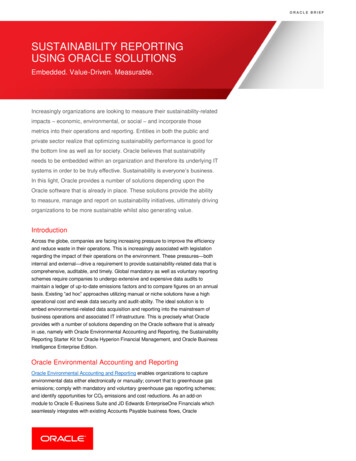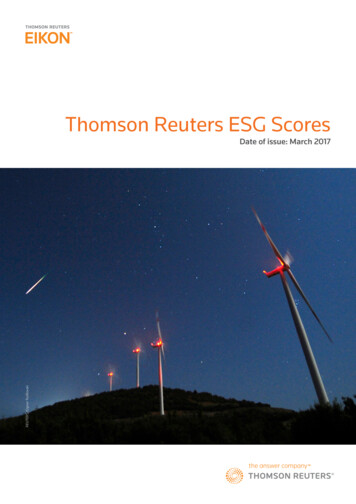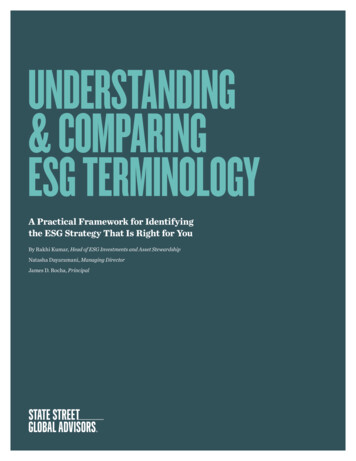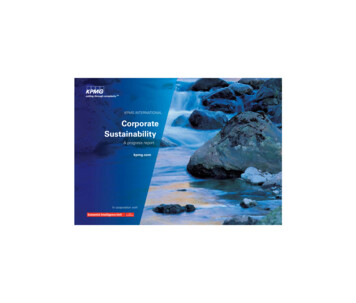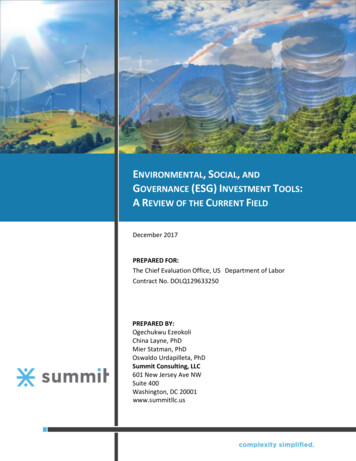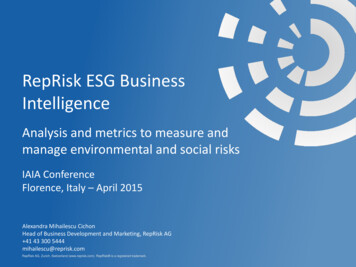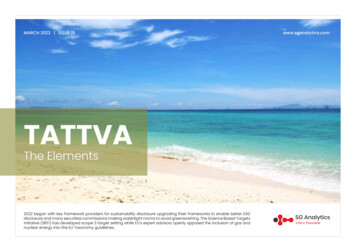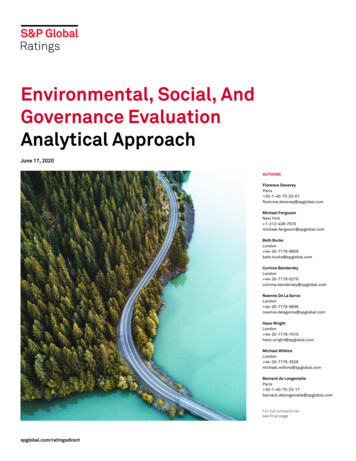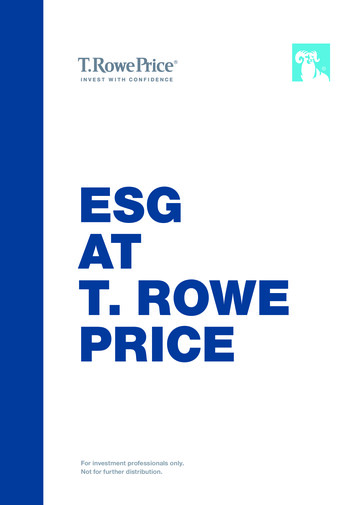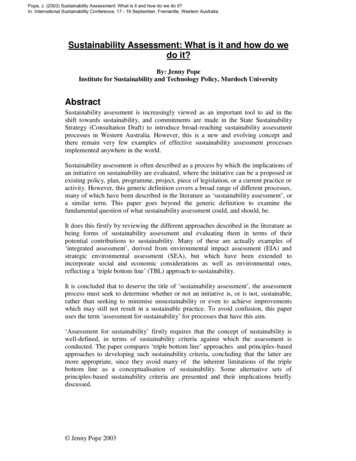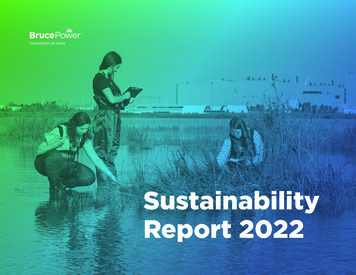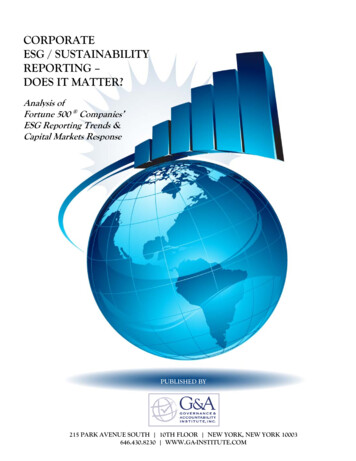
Transcription
CORPORATEESG / SUSTAINABILITYREPORTING –DOES IT MATTER?Analysis ofFortune 500 Companies’ESG Reporting Trends &Capital Markets ResponsePUBLISHED BY215 PARK AVENUE SOUTH 10TH FLOOR NEW YORK, NEW YORK 10003646.430.8230 WWW.GA-INSTITUTE.COM
DOES IT MATTER?Analysis of Fortune 500 Companies’ESG Reporting Trends & Capital Markets ResponsePublished byGovernance & Accountability Institute, Inc.215 Park Avenue South, 10th FloorNew York, New York 10003646.430.8230www.ga-institute.comPrimary Researchers & AuthorsMichelle Thompson (MPA) and Natalia Valencia (MPA)Advisors & EditorsHank Boerner, Louis D. Coppola (MBA), Alfred Modugno (MBA)CORPORATE ESG / SUSTAINABILITY REPORTINGDOES IT MATTER?CORPORATEESG / SUSTAINABILITYREPORTING –
CORPORATE ESG/SUSTAINABILITY REPORTING -- DOES IT MATTER?Background InformationOver the recent four year period (2006-2010), the number of US corporations reporting according to theframework of the Global Reporting Initiative (GRI) has been steadily increasing. The participation of UScompanies in GRI reporting is relatively low when compared with peer companies in other industrialnations.The GRI organization reported in May 2011 that 80 percent of the Global Fortune 250 companies andthe 100 largest firms based in the United States have produced Sustainability, Corporate Responsibility orESG-focused public reports in 2008 and 2009. The prevalence of reporting among the Forbes Global2000 is much lower -- just over 30%. The GRI opened a “Focal Point” office in New York City in 2010“to help US companies tell world audiences about their ESG/sustainability efforts by providing support tothose [companies] producing sustainability reports (and to boost the number of US companies producingsuch reports.”The GRI framework provides an excellent global framework for corporate sustainability and ESG reporting(reporting on corporate performance on environmental & energy, social issues and corporate governance).The breadth of issues covered in such reports can include: organization and governance; sustainabilitystrategies; energy consumption and conservations; water use and water waste; greenhouse gas emissions(GhGs); employment, human rights and labor rights issues; corporate diversity; and more.The questions raised by investment managers and corporate executives is often:does it matter if companies report according to GRI Framework does it matter if companies report or not on sustainability issues and does reporting have impact in the capital markets (and among investors)?Does reporting matter?We designed a research effort to attempt to analyze what impacts, if any, increased corporate reportingaccording to GRI Framework may have on share performance, measured against widely-used financialbenchmarks; and, if GRI reporting had influence on the reputations of corporations (positive and negative)as indicated by inclusion or exclusion in the more credible, better-known ratings and/or rankings. Ourquestion was: Does GRI reporting raise the awareness of corporate ESG performance and result incompanies being selected for credible and respected “rankings & ratings” for ESG performance and/orcorporate reputation?The preliminary research findings are contained in these pages. The model created for analysis is beingexpanded and updated and will be used by researchers to further validate or contradict the initial findingsherein.PREPARED BY GOVERNANCE & ACCOUNTABILITY INSTITUTE – COPYRIGHT 20112
CORPORATE ESG/SUSTAINABILITY REPORTING -- DOES IT MATTER?Executive SummaryThe purpose of the research and analysis was to examine the effects (if any) of certain corporatesustainability and responsibility reporting practices on stakeholders and to attempt to detect discernabletrends involving the Fortune 500 Companies as related to their ESG / Sustainability reporting. Thequestion asked by the analysts: Was there an impact of companies’ openness, transparency and willingness to reporton the enterprise’s ESG key performance indicators (KPIs) and related data sets on capital market performance?An important infrastructure for corporate ESG / Sustainability reporting is the Global Reporting Initiative(GRI), established through a collaborative process a decade ago. (GRI history is available on the GlobalReporting Initiative web site: ) The GRI isincreasingly the choice of companies in many countries for their sustainability reporting -- includingcompanies in the United States of America -- that are leading in publicly reporting on their ESGperformance and setting the pace for other business enterprises.The questions the researchers posed were:1.) Does reporting according to the GRI Framework matter to capital market players – to institutionalasset owners, professional asset managers and financial analysts?2.) Do these capital market players assign a premium to corporate issuers that report according to theGRI Framework that creates measurable share price outperformance for these companies?3.) Does GRI reporting influence the creators of leading sustainability/ESG equity indexes and relatedinvestment management products [for inclusion of reporting companies in the indices]?4.) Does GRI reporting influence the third-parties that create ranking and ratings relative to ESGcorporate performance in credible and respected compilations of leading companies? (Does it makeit more likely that reporting companies will be selected for the lists and rankings?)This research focused on two groups of companies with some degree of overlap – the constituent companiesof the Fortune 500 , as compiled annually by the editors of Fortune magazine (published by Time Warner);and, the companies that make up the S&P 500 Index , a licensed intellectual property of Standard &Poor’s Company. This index is designed for investment management and measurement, and is a widelyused benchmark for public company financial analysis and for asset management. Note: There are 500 UScompanies in each set; the overlap is about 300 companies; 200 companies are either in one set of companies or theother -- but not included in both.The Fortune 500 company list is an annual ranking of the largest 500 US companies measured by grossrevenues for the previous fiscal year. (Any company for which revenues are publicly-available is eligible forinclusion; the majority are publicly-traded enterprises; some are private concerns.)The S&P 500 Index is widely regarded as the best single gauge of the large-cap US equities market, andincludes 500 leading companies in various industries of the US economy, capturing about 75 percent ofcoverage of all US equities. Some US 4.83 trillion in Assets Under Management (AUM) investments arebenchmarked against the Index at the time of the analysis, says Standard & Poor’s. Sectors include energy,materials, industrials, construction, healthcare, financials, information technology, telecom, and utilities.PREPARED BY GOVERNANCE & ACCOUNTABILITY INSTITUTE3
CORPORATE ESG/SUSTAINABILITY REPORTING -- DOES IT MATTER?Preliminary FindingsThe researchers recognize that there are many factors that determine investor interest in specific companies,and many factors that determine share price in the capital markets. The analysis was confined to corporatesustainability disclosure and reporting, following the GRI Framework, and possible effects on corporatereputation and analyst and investor reaction.Our results showed that there was a positive correlation in 6 of the 9 of the preliminary metrics that weexamined -- the positive correlations are:Indexes For Inclusion Dow Jones Sustainability World Index This global investable index considers publicly-traded companies’ sustainability initiatives and evaluatesthe global performance of the corporate sustainability leaders.Apparent Positive impact for inclusion indicated. The managers seek “best in ESG class” companies. Dow Jones Sustainability North America Index This investable index considers companies’ sustainability initiatives and evaluates the performance ofNorth America’s publicly-traded sustainability leaders. The US company component was selected forcomparisons. The Index generally contains about 600 or fewer US companies.No discernable impact – possibly because so few US companies are reporting according to GRI Framework. NASDAQ OMX CRD Global Sustainability Global 100 Index This is an equally-weighted equity index that serves as a benchmark for stocks of companies taking aleadership role in sustainability performance reporting and [that] are traded on a major US stockexchange. The Index is comprised of companies leading in such factors as disclosing their carbonfootprint, energy usage, water consumption, hazardous and non-hazardous waste, employee safety,workforce diversity, management composition and community investing.Positive impact for inclusion determined.PREPARED BY GOVERNANCE & ACCOUNTABILITY INSTITUTE4
CORPORATE ESG/SUSTAINABILITY REPORTING -- DOES IT MATTER?Three Reputational Rankings & Lists Selected for Analysis Newsweek’s 2010 Greenest American Companies Rankings An annual assessment of the largest companies in the U.S and ranks the companies based on theirenvironmental policies, footprints and reputation.Positive impact for inclusion in the list indicated. The list is assembled by KLD Research of MSCI, using Trucostenvironmental data. Trucost has the largest such database in the world. CRO 100 Best Corporate Citizens An annual ranking of the world’s top corporate responsibility companies based on publicly-availableinformation as analyzed and ranked by IW Financial for CRO [magazine] selection.Positive impact for inclusion in the list indicated. Ethisphere’s World Most Ethical CompaniesThe companies selected for this ranking fit the criteria of Ethisphere’s motto:“Good. Smart. Business, Profit.”No discernible impact for companies included in the list.Corporate Rankings – Two Independent Ratings for Analysis Examined CRD Analytics’ SPV Ratings (SPV)A “Sustainable Performance Value” that represents a company’s total sustainability performance.Sustainability performance is defined as the environmental, social, governance and financialperformance. According to company performance, CRD assigns an SPV rating to companies from 1 to100 (highest values for highest performance). The Ratings are developed and managed by CRDAnalytics and used by asset managers.Positive impact for higher ratings indicated. Carbon Disclosure Project ScoreThe CDP is an independent not-for-profit organization focused on voluntary disclosure of greenhouseemissions, water management and climate change strategies of the largest corporations (worldwide).This score is based off the amount of data the company has supplied; the more answers completed, thehigher the score.Positive impact for higher ratings indicated (apparently related to more complete disclosure.) Carbon Disclosure Project Performance ScoreThis score is awarded for actions considered to contribute to climate change mitigation, adaption andtransparency. Actions considered to be more fundamental to progress on combating climate changeare awarded more points.Little to no correlation either positive or negative detected.PREPARED BY GOVERNANCE & ACCOUNTABILITY INSTITUTE5
CORPORATE ESG/SUSTAINABILITY REPORTING -- DOES IT MATTER?From our analysis we concluded that by their reporting according to the GRI Framework, companies couldexpect to rank higher in rankings and ratings, and have more opportunity to be recognized by the thirdparties identified here. It is generally agreed among investors that there has been no clear standard forevaluating ESG performance and that much subjectivity comes along with measuring companies’ “ethicaland sustainable” practices and performance. GRI-compliant reporting does not guarantee inclusion orhigher rankings, but does improve the chances of being recognized by some third parties such as ratings andrankings providers and index managers.The GRI Framework provides comprehensive guidelines for companies to understand the importantmetrics and narratives of ESG/Sustainability and Corporate Responsibility reporting of interest toinvestors. And which [corporate managers have been stating] helps large enterprises to better measure,manage and report on ESG strategies and performance. There are a number of sector-specific supplementswhich focus on additional material issues and indicators relative to the industry that are developedcollaboratively by stakeholders and members of the sector.To continue our initial findings from this analysis, the researchers are examining Standard and Poor 500 (S&P) 500 Companies to determine if there are similar trends for companies in that popular index.We recognize that further research is needed to understand better why certain sectors -- automobile & parts,insurance, financial – are lagging in reporting to the GRI, as well as what efforts may help to shift the USto the forefront of environmental, social, and governance (ESG) reporting, especially through reportingaccording to the GRI Framework.PREPARED BY GOVERNANCE & ACCOUNTABILITY INSTITUTE6
CORPORATE ESG/SUSTAINABILITY REPORTING -- DOES IT MATTER?Background:Introduction to GRI FrameworkIn response to growing societal concerns related to domestic and global environmental issues, includingclimate change, many multinational corporations have reacted to governmental, political, stakeholder andinvestor expectations and pressure to “anticipate,” and evaluate, understand and better manage present andfuture economic risks (and opportunities) by embracing ESG/Sustainability initiatives. (Companies oftenexplain their initiatives as being part of their overall corporate responsibility.) Expanded reporting on thesestrategies is now expected (and demanded) by increasing numbers of investors and investor coalitions, andother stakeholders.An important globally-accepted framework for accomplishing this expanded disclosure and reporting is theuse of The Global Reporting Initiative (GRI) Framework as a reporting mechanism with broad credibility.The GRI’s third generation of reporting framework and guidance – comprising the “G-3” Framework – isused by a growing number of public companies, either as a general guide or for specific reporting of theirESG performance against the Framework “indicators” and “disclosure” expectations. (The application levelsystem has various requirements and disclosures for each level.)G3.1 is a two-part guideline providing the GRI‘s Reporting Framework to aid organizations in disclosingtheir sustainability performance. Part 1 of the G3.1 Guideline consists of principles to define reportcontent, quality and to describe how to set the report boundary. Part 2 outlines the standard disclosure interms of strategy and profile, management approach, and performance indicators. G3.1 has updated itsguidance in topics such as Human Rights, Local Community Impacts, and Gender.GRI is a global, network-based mechanism (it is organized as a foundation) that has pioneered developmentof the world’s most widely-used sustainability-reporting framework. The main goal of GRI is to assistorganizations in their disclosure of environmental, social and governance (ESG) performance. A widerange of participants have embraced GRI reporting, including members of the global business community,civil society, the public sector, and labor, academic and professional institutions.Disclosure of ESG performance according to [the Framework] and voluntarily through GRI can be veryuseful to clearly demonstrate a company’s commitment to sustainable development; show compliance withenvironmental, workplace and other regulatory schemes; and, can be used to benchmark the organizationagainst peer groups, sectors and industries, and competitors.The objective of this initial analysis was to attempt to determine if there is now a discernable correlationbetween the Fortune 500 companies that do report to the GRI and the company’s capital marketperformance as measured against the broad S&P 500 Index on an [Equal Weighted Basis] performance asone important benchmark. We also looked at subjective, reputation-oriented lists, ratings and rankings, tosimilarly try to detect a benefit for the companies reporting according to the GRI Framework over a fouryear period. (Four years January 1, 2006 through April 2010.)It is important to note that investors (asset owners and managers) and financial analysts are becomingincreasingly aware that corporate financial statements alone are not determining access to capital, cost ofcapital, share price and other valuations; hence the rising interest in ESG factors.PREPARED BY GOVERNANCE & ACCOUNTABILITY INSTITUTE7
CORPORATE ESG/SUSTAINABILITY REPORTING -- DOES IT MATTER?The ESG factors once considered “non-financial” and “intangible” are becoming important determinants inthe capital markets – and tangible in the outcomes regarding valuations. How a company performs in termsof managing environmental and energy issues, addresses and resolves societal or civic issues and the state ofcorporate governance of the enterprise are three important groups of determinants, [of course] along withthe traditional financials. As investors ask about company performance with respect to the ESG factors,corporations are increasingly responding with corporate responsibility and sustainability strategies, policies,programs and initiatives. The essence of these is reported to the public in sustainability reports.These efforts lead public companies to the Global Reporting Initiative as a widely-recognized and respectedglobal framework for organization of narrative and data (metrics) and reporting on ESG performance.Inclusion on “greenest companies” and “best reputational” lists, rankings and some accompanying ratings isincreasingly sought by company managements to help to communicate the firm’s efforts to be more“sustainable and responsible,” and therefore position the enterprise to be more appealing to investors whocare about such efforts.PREPARED BY GOVERNANCE & ACCOUNTABILITY INSTITUTE8
CORPORATE ESG/SUSTAINABILITY REPORTING -- DOES IT MATTER?MethodologyIn our research we analyzed and reported on how Fortune 500 companies performed against the widely-usedS&P500 index, an important benchmark, and if they did or did not report according to the GRIFramework. (US Companies have been increasing their ESG reporting in every year from 2006 to 2010,the base years of our analysis.)Our hypothesis was that companies that do voluntarily report according to the GRI Framework in theirESG/Sustainability reporting would have a higher probability to be added to sustainability--focused equityindices and to be selected for inclusion on popular sustainability lists and rankings as compared to nonreporters.One example: We examined certain popular and credible corporate reputation and ESG-factored rankings such as Newsweek’s Greenest Companies Rankings to determine if there was a correlation between acompany’s selection for this annual ranking (which has US companies ranked #1 to #500) and if thecompanies included in the ranking reported to the GRI in any years from 2006 to 2010. Our analysis ofNewsweek’s Greenest Companies Rankings included categorizing companies in two groups consisting ofthe top 250 rankings and the bottom 250 rankings to further examine any correlation with GRI Reporting.Our research indicated that there is a correlation between more disclosure and being selected for inclusionin Newsweek Greenest Companies Ranking, NASDAQ OMX CRD Sustainability Global 100, and theDow Jones Sustainability Index - World (DJSI World). It also indicated that there was a correlation withbetter scores for GRI reporters in the CRD Sustainable Performance Value (SPV) Ratings, CarbonDisclosure Project (CDP) Score, and CRO 100 Best Corporate Citizens.We found that there was little discernable correlation for selection and inclusion for the ratings andrankings of (3) Ethisphere’s World’s Most Ethical Companies and the Carbon Disclosure Project (CDP)Performance score, and for inclusion in the Dow Jones Sustainability Index – United States (DJSI US).We observed that companies based outside the United States have a better record of sustainability andresponsibility reporting according to the GRI Framework than do many of their US counterparts. Out ofthe entire universe of global GRI reporters only 12-14% are from US, companies; in contrast, 45%currently originate from a European-based corporation.We concluded (as of end of April 2011, close of initial analysis) that further analysis on the importantfactors that determine company’s selection for reputable ratings and rankings is needed. That workcontinues beyond this report and will be the subject of a later report. The database constructed for thisresearch effort is being expanded to include additional rankings, ratings and other data points.To evaluate companies’ potential appeal to investors, possible selection for sustainability stock indexes andselection for reputational lists we compiled data and analyzed the results correlated with GRI corporatereporting trends (for the years 2006-2010). The first step was to evaluate the general trend of GRI corporatereporting during the period 2006 to 2010, with special attention to the latest year, corporate sustainabilityreporting in the year 2010.In determining the ratings to be included in the analysis, we selected three equity indexes, two ratings andfour reputational rankings to determine whether or not reporting to the GRI did result in measurablecapital markets benefits.PREPARED BY GOVERNANCE & ACCOUNTABILITY INSTITUTE9
CORPORATE ESG/SUSTAINABILITY REPORTING -- DOES IT MATTER?Results of GRI Reporting AnalysisCorporations voluntarily reporting according to GRI Framework are of diverse backgrounds. Reportingorganizations overall represent global business, civil society, labor, academic and professional institutions.Corporations reporting to GRI are encouraged to follow a generally-accepted framework for financialreporting – the G3.1. This framework is structured in a way that all types of organizations can use it. TheG3.1 offers useful guidelines for determining what to report and how to achieve higher level of disclosure ofmeaningful data and information. (Note that development of the G-4 Framework is a work-in-progress. Also, thereare a number of Sector reporting guidelines already developed in a collaborative process; some are in pilot stage.)GRI Corporate Reporting - Years 2006 – 2010 AnalysisThe first analysis consisted of studying the general trend of GRI reporting by US companies from 2006 to2010. We analyzed companies from the Fortune 500 list of 2009 and compared their reporting over time.GRI Reporting 2006‐2010 ‐ Percentageof total F‐500 Companies reporting20%15%10%5%0%20062007200820092010Figure 1. Increase in GRI reporting by Fortune 500 Companies, 2006 to 2010.As depicted in the bar graph above there has been a steady increase in the number of Fortune 500companies reporting according to the GRI Framework. In 2006, only five percent (5%) of F-500 werereporting; in 2007, the percentage rose to 7%. In 2008, 15% of F-500 companies reported; in 2009, 17%;and in 2010, over 19% of the F-500 reported. The 2010 reports are still being issued; some companies donot issue their report until mid-year or later. The total year reporting analysis will be completed infall/winter 2011.Note: Governance & Accountability Institute was appointed the Data Partner of the GRI June 1, 2011and is now collecting and analyzing the sustainability and responsibility reports of US companies. Thateffort will aid in the analysis that continues after these initial findings.PREPARED BY GOVERNANCE & ACCOUNTABILITY INSTITUTE10
CORPORATE ESG/SUSTAINABILITY REPORTING -- DOES IT MATTER?At least 23% of all F-500 companies did report at least once during the period 2006-2010. It is important tonote that companies that reported once in 2006 but did not report after that year were also included in ouranalysis. Among the F-500, 77% of the companies did not report to GRI at least one time in the 2006-2010reporting years.All Fortune 500 Companies23%Reporting GRI77%Not Reporting GRIFigure 2. Percentages of Fortune 500 companies voluntarily reporting according to theGRI Framework – all sectors and industries – for the 2006-2010 reporting year analyzed.PREPARED BY GOVERNANCE & ACCOUNTABILITY INSTITUTE11
CORPORATE ESG/SUSTAINABILITY REPORTING -- DOES IT MATTER?Sector LeadershipIn analyzing companies reporting according to the GRI Framework in 2010, we found that the highestnumber of companies was in the utilities super sector1, followed by technology and foods and beveragesectors. Sectors such as financial services and insurance were not as well represented. Here is a breakdownof United States corporate sector reporting:UtilitiesTechnologyFoods & BeveragesPersonal & Household ProductsHealth CareRetailOil & GasBasic ResourcesTravel & LeisureConstruction & MaterialsChemicalsTelecommunicationsIndustrial Goods & ServicesAutomobiles & PartsInsuranceFinancial Services0%2%4%6%8%10%12%14%16%18%Figure 3. Percentage of super sector reporting to GRI1GRI organizes companies in 19 super sectors to help classify companies accordingly. These are: automobiles & parts,banks, basic resources, chemicals, construction & materials, financial services, food & beverage, health care, industrialgoods & services, insurance, media, oil & gas, personal & household goods, real estate, retail, technology,telecommunications, travel & leisure, and utilities.PREPARED BY GOVERNANCE & ACCOUNTABILITY INSTITUTE12
CORPORATE ESG/SUSTAINABILITY REPORTING -- DOES IT MATTER?GRI Application Levels – C, B, AThis chart depicts the GRI application level for US companies from 2006 to 2010. There are three basiclevels in GRI system – “A,” “B” and “C.” Levels A, B and C “plus” ( ) are also available. The plus ( ) signindicates that the report has been externally assured by a third party.Application LevelAA BB CC Not KnownUTotal 334420095319415213522010942531560365Figure 4. Numbers of US F-500 companies in each GRI level from 2006 to 2010.Note: The application level assigned varies according to the level/scope of the reporting and notto the sustainability performance of the company. A “C” level, for example, is not comparableto a C in the USA’s “A, B, C” levels of school grading.PREPARED BY GOVERNANCE & ACCOUNTABILITY INSTITUTE13
CORPORATE ESG/SUSTAINABILITY REPORTING -- DOES IT MATTER?4-Year Share Price PerformanceComparisonsIn this analysis we created two baskets of stocks which were re-balanced on the 1st of January each year basedon changes in inclusion criteria. At the start of each year we add the companies that report to theportfolio. If a company does not report for two consecutive years, we remove the company from theportfolio. We allowed a one year gap in reporting, as long as the company reports the following year.(1) The S&P 500 GRI Reporters consists of companies in the S&P 500 as of March 30, 2011 that havereported to GRI at any level.(2) The Fortune 500 GRI Reporters consists of companies in the Fortune 500 2009 list that have reportedto GRI at any level.These two baskets were then benchmarked against the S&P 500 EWI (Equal Weighted Index) forcomparison. The detailed performance analysis chart can be seen in Appendix I. Below you can see thereturns of each basket in periods of 1 Year, 2 Years, 3 Years, 4 Years, Total, and Year-To-Date 2011 (YTD).GRI [corporate] Reporters from both S&P 500 and Fortune 500 outperformed the S&P Equal WeightedIndex in most time periods, and tended to have a higher outperformance the longer the period of time.This seems to further illustrate the value of selecting sustainable and responsibility business enterprises tothe long-term sustainable and responsible investor, which public companies increasingly are interested inattracting as sources of long term, patient capital investments.IndexesS&P 500GRI ReportersFortune 500GRI ReportersS&P 500EWI1 YearReturn2 YearReturn3 YearReturn4 .81%71.64%1.28%1.34%6.66%4.06%PREPARED BY GOVERNANCE & ACCOUNTABILITY INSTITUTE14
CORPORATE ESG/SUSTAINABILITY REPORTING -- DOES IT MATTER?Indices AnalysisThree (3) Sustainability-themed indexes were initially selected to analyze whether or not there was anyindication of a correlation between US companies that reported according to the GRI Framework and theinclusion in any of these companies in the three indexes.Note: The Dow Jones Sustainability Indexes were launched in 1999. More than 70 licenses are held by asset managersin 19 countries and are used to manage active and passive funds with more than US 8 billion AUM based on theDJSI. Note that the US companies are part of the North American DJSI (list as of March 31, 2011).Dow Jones Sustainability Index North AmericaThe top 20 percent of the 600 largest companies in North America are evaluated for inclusion in the DJSI.The Index is developed in collaboration with Sustainable Asset Management (SAM) Group (Switzerlandbased ESG researchers and asset managers) for Dow Jones & Company, owners of the DJSI.DJSI North America Companies and GRI Reporting(DJSI North America)30%GRI Reporting70%No GRI ReportingFigure 5. Percentage of companies reporting to GRI from 2006 to 2010which were included in the DJSI North America Index.We found that 30% of the companies that are included in the DJSI North America Index were reportingto the GRI; 70% did not report. When compared to the DJSI World analysis (following chart), thesefindings seem to indicate that European companies that are leading in ESG/Sustainability transparency andmore active in GRI Framework reporting are viewed by more favora
Note: There are 500 US companies in each set; the overlap is about 300 companies; 200 companies are either in one set of companies or the other -- but not included in both. The Fortune 500 company list is an annual ranking of the largest 500 US companies measured by gross revenues for the previous fiscal year.
